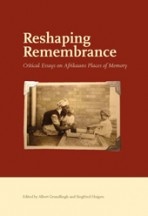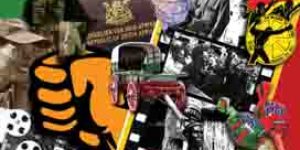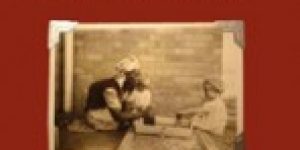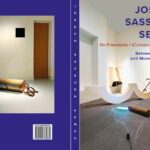Reshaping Remembrance ~ The Woordeboek van die Afrikaanse Taal
No Comments yet 1.
1.
For the average language user, a dictionary is something that you do not argue with, that you rely on with varying levels of success to regain lost knowledge, for help with crossword puzzles and that you sometimes, very successfully, use to press flowers or as a doorstop. But despite the nature of the use of a dictionary – whether it is in fulfilling its genuine purpose or not – the typical user sees the dictionary as an authoritative container of grammatical and other information that provides the holy truth. That’s why in spoken language people do not refer to ‘a dictionary’ but to ‘the dictionary’ – almost like The Bible. Not everybody is aware of the existence of a variety of dictionary types, each having to comply with its own typological criteria and help a specific target user group in a particular way to meet their specific needs in accordance with their research skills. One particular dictionary can’t be everything for everybody – that is something that dictionary users often have to be reminded of. The fact that each specific dictionary has a distinct role in the recording and reproduction of language is also seldom emphasised. Moreover, the fact that between the wealth of dictionaries there is one which can be seen as the crown jewel of the dictionary family is also not always recognised. This jewel is the comprehensive explanatory dictionary, and in Afrikaans this typological place is occupied by the Woordeboek van die Afrikaanse Taal (Dictionary of the Afrikaans Language), commonly known as the WAT.
The WAT as comprehensive dictionary is a source of information – as supplement, as affirmation and often also as reminder. But as Afrikaans source of reminding it is not only the content of the Woordeboek van die Afrikaanse Taal that is relevant, but the history of this dictionary as well that calls one’s attention to numerous places of remembrance. As far as the content of the WAT is concerned, one must take note of the fact that a comprehensive dictionary typically consists of multiple volumes compiled over decades – for example, it took 148 years to complete the comprehensive Het Woordenboek der Nederlandsche Taal (The Dictionary of the Dutch Language). The comprehensiveness of such a dictionary lies in its choice of items included for treatment, in the variety of data types that are treated in the dictionary as well as the nature and the extent of their treatment. The comprehensiveness with regard to the choice of words brings about the fact that such a dictionary includes a lot of words and phrases for treatment and in that way makes the user aware of various old and lesserknown language forms. The dictionary becomes a recollection of bygone and less ordinary language use; this is what the WAT is par excellence. In his reaction to a very negative discussion of his Webster’s Third New International Dictionary of 1961 in Life magazine, a discussion which, like many others, condemned this dictionary for not being prescriptive enough, the American lexicographer Philip Gove said the following:
The responsibility of a dictionary is to record language, not set its style. For us to attempt to prescribe language would be like Life reporting the news as its editors would prefer it to happen.
The way in which a dictionary gives account of language and language use is determined by the dictionary types, the dictionary’s functions and, especially, the target users and their needs. Smaller dictionaries, like school, learners’ and even standard dictionaries aim to portray the standard variety of a language.[i] A comprehensive dictionary, however, has to give a comprehensive account of the given language. As a comprehensive dictionary, the WAT is seen as the most exhaustive Afrikaans lexicographic source. It is the dictionary which must portray the full extent of Afrikaans with all its varieties and dialects, the dictionary which has to give an exhaustive account of the Afrikaans lexicon, the dictionary which, through its choice of items, becomes a treasure chest of the language filled with lexical places of remembrance. While a smaller dictionary like a standard dictionary is aimed at the present and the future and therefore has a stronger normative role, the inclusion and treatment in a comprehensive dictionary is aimed at the past and the present and the dictionary therefore has a strong informative approach. The informative nature of the WAT forces the lexicographers to acknowledge the standard as well as non-standard varieties of Afrikaans. There may not exist a purist attitude that tries to isolate the Afrikaans language from the influence of other South African languages, that tries to ignore the reality and the influence of contact among languages, or that tries to allay the dynamic nature of language change. The real language of the real language users as practiced in actual usage situations should be treated in this dictionary. As a language treasure the WAT must record, treat and protect the lexical riches of Afrikaans – and allay the sentence of evanescence. By focusing on the present as well as on the past, the WAT must become a place of remembrance for members of the Afrikaans community where words as well as other aspects of language can be recalled.
Paging through any of the thirteen volumes of the WAT that have already appeared calls up many memories for Afrikaans native speakers. The variety of dialects as well as idioms and set expressions confirms the richness of Afrikaans. The strong Dutch basis of older Afrikaans, in addition to the numerous non-Dutch words of both the present and recent past also show the influence of other languages, particularly English. This choice of words gives a clear indication of the changing nature of the Afrikaans vocabulary. A noticeable difference between recent volumes and older ones can be found in the inclusion and treatment of technical language. During the earlier phases of the WAT’s development, there were not enough Afrikaans technical dictionaries and the WAT consequently included and treated numerous technical terms. Today the Afrikaans technical lexicography is well developed and the WAT only records a limited part of that section of the Afrikaans lexicon. It is specifically the technical terminology used in communication between expert and lay person that is considered for inclusion in the WAT.
Frequent reference has been made to the linguistic content of the WAT and will therefore not be discussed here. The emphasis of this contribution falls rather on certain aspects of the origin, development and positioning of the WAT. The focus therefore is not on an approach from the theoretical lexicography, but rather on the reality of the lexicographic practice.
2.
Many good and bad memories are linked to the history of the WAT. There are memories of how to do something right and how not to do it; memories of how not to start something and indications of how to complete something; memories of isolated struggles, but also memories of successful cooperation between theory and practice; memories of insensitive dealings with language and attempts to overcompensate for this insensitivity; memories of how to become the catalyst for the development of a new discipline, but also of how to be the stimulus for further growth in this discipline.
The early history of the WAT has been thoroughly documented by among others Snijman (1964) and especially Gericke (1991). The work on the WAT started in 1926 but was preceded by a lot of preparation work, although history would show that this preparation was not aimed sufficiently at the compilation of a comprehensive dictionary. The initial plan was to compile a much smaller dictionary meant to be completed in three years. According to a further agreement, that dictionary should have been completed by 1936 but that did not happen. In 1944 part of Smith’s manuscript was handed over to Prof. J. du P. Scholtz for review. His findings were, among others, that there was a lack of direction from the editor in chief. When the first editor-in-chief, Dr J.J. Smith, took early retirement due to illness in 1945, nothing had as yet been published. Years later, a later editor-in-chief, Dr. F.J. Snijman, made the following comment with regard to Smith’s retirement: ‘For his own feeling both his life’s work and his life ended in ruins’.[ii] From this memory, future editors-in-chief could learn the necessity of including thorough planning and direction as essential elements of the WAT.
Although according to the initial contract between the Minister of Education and Home Affairs, Nasionale Pers (National Press – currently Media 24) and the University of Stellenbosch the dictionary was supposed to be compiled with government support, a lack of government funds resulted in the University of Stellenbosch carrying the financial responsibility of the dictionary project on their own from April 1945 to March University would play through the years – and still plays today.
For many people, slow progress has become one of the lasting memories of the WAT. During a meeting of the Board of Control in March 1946 it was decided by the Board that ‘a new editor-in-chief must agree to the completion of a manuscript of the whole dictionary ready for press in a period of five years after the starting of his term of office and … to the publication of a number of letters two years after his commencement of office’.[iv] The position was offered to Prof. J. du P. Scholtz who declined it because: ‘I don’t have the conviction that the Dictionary is placed on the foundation necessary for its satisfactory continuation and completion’.[v] According to him it was also impossible to complete the work within five years. The validity of Scholtz’s finding would be confirmed in the years that followed.
In January 1947 Dr. P.C. Schoonees became the second editor-in-chief. This was actually a new beginning and not just a continuation of the editorial work of the WAT. In the modern lexicographic theory the compilation of a dictionary plan according to which the editorial work is set out in detail is seen as one of the most important early phases of any lexicographic process. Dr. Schoonees not only arranged for the compilation work of the WAT to start afresh, but also worked out a set of general editorial principles. Good progress during Schoonees’s term was however followed by a very slow approach during the term of his successor, Dr. F.J. Snijman. Volume IV (H-I) of the WAT was released in 1961 and was the last volume under the chief editorship of Dr. Schoonees. The first volume under the chief editorship of his successor, Volume V (J-KJ), was released in 1968. The letter ‘K’ became a serious swamp for the WAT because Volume VI which appeared in 1976 only covered the partial article stretch KLA-KOL and Volume VII (KOM-KOR), partly under the editorship of Snijman and partly under the editorship of his successor, Mr. D.C. Hauptfleisch, appeared in 1984.
With the release of Volume VIII (KOS-KYW) the letter ‘K’ was finally completed in 1991. Critics strongly spoke out against, among other things, the slow progress. They even were of the opinion that if that pace was kept up, it would take a further 120 years to complete the WAT. During Hauptfleisch’s term, the editorial team seriously reflected on the slow progress and a new editorial system brought about real change which lead to an increased pace. This was also characteristic of the era of Dr. D.J. van Schalkwyk and applies as well to the term of the current editor-in-chief, Dr. W.F. Botha, although forced personnel cuts led to a slight deceleration. Since 1991 the increased pace led to the completion of Volume IX (L) in 1994, Volume X (M) in 1996, Volume XI (N-O) in 2000, Volume XII (P-Q) in 2005 and XIII (R) in 2009. The current projection is that the WAT will be completed by 2025. The memories of progress that was too slow led to a reality of increased production.
3.
The WAT as comprehensive lexicographic project’s reflection of the full lexicon of Afrikaans not only provides memories of language forms, but the history of this dictionary also indicates a significant influence on the interaction with theoretical lexicography.
The fact that, when work on the WAT was started, the compilation of a comprehensive explanatory dictionary for Afrikaans was premature, can be seen when looking at the reaction to the publication of the first volumes. At that stage in the broad field of Afrikaans linguistics there was very little talk indeed of attention to theoretical lexicography. Therefore no review or discussion followed that focused on the lexicographic quality of the WAT. There were however short discussions and announcements which showed a very positive reaction on the release of each volume and saw it as a ’national event’.
The first full discussion of a volume of the WAT was that of Combrink (1962), a probing critique of Volume IV.[vi] Although other contributions on the level of theoretical lexicography had been made earlier and were still being made in those years, Combrink’s review took a new course, namely a linguistic-based critique of the WAT.[vii]
In the general development of the lexicography it was also still an early phase, characterised by a strict focus on the linguistic content of dictionaries.[viii] That was also one of the core elements of Combrink’s review. Even more important than the value of Combrink’s review as a commentary on the WAT was the fact that it was the start of valuable development of lexicographic theory in Afrikaans – and in this the WAT played no small role. For approximately two decades after the publication of Combrink’s review the most important contributions to the theoretical lexicography of Afrikaans were probing discussions of the various volumes of the WAT.[ix] The WAT wasn’t only a stopover for language users with a thirst for knowledge of the language, but also for linguists and theoretical lexicographers who wanted to quench their thirst for criticism. The important role of the WAT in the development of the theoretical lexicography of Afrikaans should never be underestimated. Initially it was a catalyst – something causing change without changing itself. The change regarded the interest of Afrikaans linguists in lexicography, but despite their fierce criticism, the feeling existed that it led to little change in the WAT. However, the WAT played a double role in this development: besides being the catalyst, it was also the stimulant and the target of the lexicographical discussion, but also a product which finally reacted to the criticism.
Change eventually came and theory and practice showed interaction. On the one hand the lexicographic practice of the WAT in due course made changes which led to the improvement of the lexicographic work, but on the other hand the Afrikaans theoretical lexicography also adapted due to the method of work and suggestions from the practice of the WAT. In this process the WAT must be seen as the most important stimulus in the development of theoretical lexicography in Afrikaans.
Lexicographers must refrain from placing themselves between a word and its meaning. As repository of information, a dictionary should not reflect the subjective views of its compilers. Prejudice on the level of for example politics and religion or the insensitive handling of sexist or racist words is not acceptable – also not in a comprehensive dictionary. It does not however prevent the lexicographer from including such words. But the way in which they are presented and treated is important.
Earlier volumes of the WAT didn’t always treat such words with the necessary sensitivity. Especially Volume V (1968), the volume in which the alphabetical partial article stretch K-KJ was treated, is an example of the insensitive treatment of lexical items with a racist value. But even in later volumes, among others Volume VII (KOMKOR) (1984), the necessary sensitivity in this regard is still not sufficient.
A fundamental breakthrough came in 1989 when a discussion on the lexicographic treatment of sensitive items was organised by Dirk van Schalkwyk. Besides the WAT’s editorial staff, a number of local and overseas linguists as well as practical and theoretical lexicographers were invited to participate in the discussion. Invitees who were unable to attend were asked to provinde their comments in writing. During this discussion, the quality of the WAT as place of remembrance came under fire during the planning and the discussion.
The event took place at a time of extreme sensitivity with regard to different forms of racism – especially in connection to the more insensitive treatment in the volumes of the WAT that had already been published. In order to show the WAT’s new sensitivity with regard to racist language use, the editorial staff suggested that all racist lexical items must be excluded from future volumes of the WAT. Some participants agreed, but others found this unacceptable. It was argued that the WAT would then neglect its duty to account for the full lexical stock of Afrikaans. One of the prominent international metalexicographers, Prof. Ladislav Zgusta, who could not attend the event but sent his comments to the editorial staff, summarised the matter well by saying that such as a plan of action would amount to ‘lexicographic myopia’. It was then decided that sensitive terms would be included, clearly labelled and treated briefly and to the point.
The complete collection of recordings of the word’s use would be stored in the WAT’s electronic corpus where it would be accessible to researchers. A dictionary like the WAT may not only be a purist reminder of all that is well and good in the language, but should also remind us of words and the use of words that are to the detriment of the language.
4.
During the last decade the WAT has also focused increasingly on acting as a source of remembrance on another level. In the treatment of Afrikaans in general, insufficient attention has been paid to the description and treatment of etymology. Cooperation between the Buro van die WAT and the Instituut voor Nederlandse Lexicologie in Leiden led to the publication of Etimologiewoordeboek van Afrikaans (2003) and its supplement in 2007. These two products of the WAT have also become valuable sources of remembrance for and of Afrikaans.
Despite a hesitant start and a rough middle phase, the WAT is currently well underway to treat comprehensively the lexicon of Afrikaans. The dictionary therefore provides a lot of food for thought about Afrikaans. Within the broader Afrikaans lexicographic terrain, one of the most important places of remembrance in the development of the WAT is its contribution to the establishment of the theoretical lexicographical discussion in South Africa.
NOTES
i. Compare the discussions on typology in numerous places, among others Zgusta, L. Manual of Lexicography. Den Haag: Mouton 1971; Gouws, R.H. & Prinsloo, D.J. Principles and Practice of South African Lexicography. Stellenbosch: SunMedia 2005 and Gouws, R.H. Leksikografie. Cape Town: Academica 1989.
ii. Unpublished. Snijman, F.J. Die Afrikaanse Woordenboek teen sy agtergrond. Manuscripts: WAT archives 1963, 163.
iii. F.J. Snijman, U woorde, u woordeboek. Stellenbosch: Raad van Beheer oor Die Afrikaanse Woordeboek 1964, 14.
iv. F.J. Snijman, U woorde, u woordeboek. Stellenbosch: Raad van Beheer oor Die Afrikaanse Woordeboek 1964, 14.
v. Ibid.
vi. J.G.H. Combrink, ‘‘n Prinsipiële beskouing oor WAT IV’, in: Tydskrif vir Geesteswetenskappe 2 (4) (1962), 199-221.
vii. Compare S.P.E. Boshoff: ‘‘n Standaardwoordeboek van Afrikaans’, in: Gedenkboek ter ere van die GRA. Potchefstroom, (1926), 307-328, F.F. Odendal, ‘Leksikografiese probleme I’, in Standpunte 14(6) (1961), 53-61, F.F. Odendal, ‘Leksikografiese probleme II’, in Standpunte 15(1) (1961a), 49-54 and F.F. Odendal, ‘Leksikografiese probleme III’, in Standpunte 16(5) (1962), 48-55.
viii. Compare R.H. Gouws, ‘Meilensteine auf dem historischen Weg der Metalexikographie’, in Lexicographica 21 (2005), 158-178.
ix. Compare J.G.H. Combrink, ‘Die sesde deel van die WAT’, in: Standpunte 140 (32-2) (1979), 49-64, Odendal, F.F. ‘Plus positief en plus negatief’, in Tydskrif vir Geesteswetenskappe 19 (1) (1979), 24-41 and R.H. Gouws, ‘Die sewende deel van die Woordeboek van die Afrikaanse Taal’ in: Standpunte 185 (1985), 13-25.
References
Unpublished
Snijman, F.J. Die Afrikaanse Woordeboek teen sy agtergrond (Manuscript: WAT archives), 1963.
Published
Boshoff, S.P.E. ‘’n Standaardwoordeboek van Afrikaans’, in: Gedenkboek ter ere van die GRA. Potchefstroom, 1926, 307-328.
Combrink, J.G.H. ‘’n Prinsipiële beskouing oor WAT IV’, in: Tydskrif vir Geesteswetenskappe 2 (4) (1962), 199-221.
Combrink, J.G.H. ‘Die sesde deel van die WAT’, in: Standpunte 140 (32-2) 1979, 49-64.
De Vries, M. et al. (eds.). Woordenboek der Nederlandsche Taal. ’s-Gravenhage: SDU Publishers 1864-1998.
Gericke, W. Die Woordeboek van die Afrikaanse Taal – ’n kultuurhistoriese verkenning. Unpublished thesis, University of Stellenbosch 1991.
Gouws, R.H. ‘Die sewende deel van die Woordeboek van die Afrikaanse Taal’ in: Standpunte 185 (1985), 13-25.
Gouws, R.H. Leksikografie. Cape Town: Academica 1989.
Gouws, R.H. ‘Meilensteine auf dem historischen Weg der Metalexikographie’, in Lexicographica 21 (2005), 158-178.
Gouws, R.H. & Prinsloo, D.J. Principles and Practice of South African Lexicography. Stellenbosch: SunMedia 2005.
Gove, P.B. Webster’s Third New International Dictionary Springfield, Massachusetts: Merriam-Webster 1961.
Odendal, F.F. ‘Leksikografiese probleme I, in Standpunte 14(6) (1961), 53-61.
Odendal, F.F. ‘Leksikografiese probleme II’, in Standpunte 15(1) (1961a), 49-54.
Odendal, F.F. ‘Leksikografiese probleme III’, in Standpunte 16(5) (1962), 48-55.
Odendal, F.F. ‘Plus positief en plus negatief’, in Tydskrif vir Geesteswetenskappe 19 (1) (1979), 24-41.
Snijman, F.J. U woorde, u woordeboek. Stellenbosch: Raad van Beheer oor Die Afrikaanse Woordeboek 1964.
Van Wyk, G. et al (eds.). Etimologiese woordeboek van Afrikaans. Stellenbosch: Buro van die WAT 2003.
Zgusta, L. Manual of Lexicography. Den Haag: Mouton 1971.
You May Also Like
Comments
Leave a Reply




